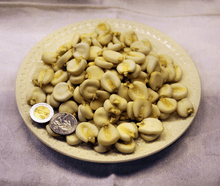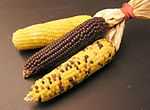Hominy
Hominy is a food which consists of dried maize kernels which have been treated with an alkali in a process called nixtamalization.
Production
To make hominy, field corn (maize) grain is dried, then treated by soaking and cooking the mature (hard) grain in a dilute solution of lye, slaked lime (calcium hydroxide) or wood ash, a process termed nixtamalization. The soaked maize is washed, and then ground into masa. When fresh masa is dried and powdered, it becomes masa seca or masa harina.
Lye, lime and ash are highly alkaline: the alkalinity helps the dissolution of hemicellulose, the major glue-like component of the maize cell walls, and loosens the hulls from the kernels and softens the corn. Some of the corn oil is broken down into emulsifying agents (monoglycerides and diglycerides), while bonding of the corn proteins to each other is also facilitated. The divalent calcium in lime acts as a cross-linking agent for protein and polysaccharide acidic side chains. As a result, while cornmeal made from untreated ground corn is unable by itself to form a dough with the addition of water, the chemical changes in masa allow dough formation, which is essential to the ability to fashion dough into tortillas. Also, soaking the corn in lime[1] kills the seed's germ, which keeps it from sprouting while in storage. Finally, in addition to providing a source of dietary calcium, the lime reacts with the corn so that the nutrient niacin can be assimilated by the digestive tract. While consumption of untreated corn is a risk factor in predisposition to pellagra, the risk is dramatically reduced or eliminated by nixtamalization.
The process of making hominy is also called nixtamalization and the ground product can be called masa nixtamalera.
The earliest known usage of nixtamalization was in what is present-day southern Mexico and Guatemala around 1500–1200 BC.
Recipes
In Central American and Mexican cuisine, masa nixtamalera is cooked with water and milk to make a thick, gruel-like beverage called atole. When made with chocolate and sugar, it becomes atole de chocolate. Adding anise and piloncillo to this mix creates champurrado, a popular breakfast drink.
The English term hominy is derived from the Powhatan language word for prepared maize.[2] Many other Native American cultures also made hominy and integrated it into their diet. Cherokees, for example, made hominy grits by soaking corn in a weak lye solution obtained by leaching hardwood ash with water and beating it with a kanona (ᎧᏃᎾ), or corn beater.[3] The grits were used to make a traditional hominy soup (gvnohenv amagii ᎬᏃᎮᏅ ᎠᎹᎩᎢ), a hominy soup that was allowed to ferment (gvwi sida amagii ᎬᏫ ᏏᏓ ᎠᎹᎩᎢ),[4] cornbread, dumplings (digunvi ᏗᎫᏅᎢ),[5] or, in post-contact times, fried with bacon and green onions.
Some recipes using hominy include pozole (a Mexican stew of hominy and pork, chicken, or other meat), hominy bread, hominy chili, hog 'n' hominy, casseroles and fried dishes. Hominy can be ground coarsely to make hominy grits, or into a fine mash (dough) to make masa, a dough used regularly in Latin American cuisine. Many islands in the West Indies, most notably Jamaica, also use hominy (known as cornmeal or polenta) to make a sort of porridge with corn starch or flour to thicken the mixture and condensed milk, vanilla and nutmeg to taste. In Italian cuisine a similar usually savoury dish is eaten, known as polenta (cornmeal) often accompanying meat.
Rockihominy, a popular trail food in the 19th and early 20th centuries, is dried corn roasted to a golden brown, then ground to a very coarse meal, almost like hominy grits. Hominy is also used as animal feed.
See also
| Wikibooks Cookbook has a recipe/module on |
| Look up hominy in Wiktionary, the free dictionary. |
References
- ↑ Thigpen, Susan (October 1983). "Hominy - Mountain Recipe". The Mountain Laurel. Retrieved 17 November 2013.
- ↑ Galiano, Amanda. "Southern Slang: G-P". About.com. Retrieved 17 November 2013.
- ↑ "Hominy Soup #3 (Gv-No-He-Nv A-Ma-Gi-i)". Native Way Cookbook. Wisdom Keepers, Inc. Archived from the original on 26 April 2009. Retrieved 17 November 2013.
- ↑ "Hominy Soup #1 (Gv-Wi Si-Da A-Ma-Gi-i)". Native Way Cookbook. Wisdom Keepers, Inc. Archived from the original on 26 July 2009. Retrieved 17 November 2013.
- ↑ "Dumplings, Lye (Di-Gu-Nv-I)". Native Way Cookbook. Wisdom Keepers, Inc. Archived from the original on 2 November 2000. Retrieved 17 November 2013.
| ||||||||||||||||||||||||||||||||||||||||||||||

